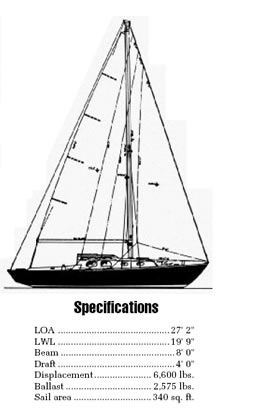
The Bristol 27 is a product of an early collaboration between Clint Pearson of Bristol, Rhode Island, and designer Carl Alberg. The stamp of both men is clearly evident in this solid-as-a-rock traditionally styled small cruiser.
The Boat and the Builder
Pearson, with his cousin Everett Pearson, was a founder of the original Pearson Yachts in 1955 and a pioneer in the mass production of fiberglass yachts. The boat that brought the company to prominence was the 28-foot Triton, drawn by Alberg, who at the time was still in the U.S. Coast Guard and designing boats on the side. Clint Pearson recalled recently that the Triton and subsequent Alberg designs were so successful that the firm found it cheaper to hire a full-time naval architect (Bill Shaw) than to work with Alberg on a royalty basis. (Alberg died in 1983.)
But when Clint Pearson left Pearson Yachts in the early 1960s, after Grumman Allied Industries bought the company, he quickly turned to Alberg for help with his new line of semi-custom boats. The Triton had been very popular, Pearson said, and Carl had been a nice guy to work with. Alberg drew the lines for a 27-footer to complement Bristol Yachts only other model, a 19-footer, and the first Bristol 27 was built in the spring of 1965.
At this point, no one is sure exactly how many of the 27s were built. An early Bristol Yachts brochure says that more than 300 were sold in the first three years. The best guess is that 400 or more were built between 1965 and the mid-1970s. Because of their rugged construction, its safe to say that most of them are still plying the waters somewhere today.
Except for the 1970s-era Bristol 24, designed by Paul Coble, and the 27.7, designed by Halsey Herreshoff, Bristol in recent years has concentrated on much larger boats. The company, although much reduced in workforce, was still operating inthe fall of 1991, concentrating on the 47.7 and a 35.5, both Ted Hood designs.

The Design
The Bristol 27 is a product of its era and of the traditional bent of Albergs thinking-that is, a combination cruiser and club racer. At 6,600 pounds displacement with 2,575 pounds of internal lead ballast in its full keel, the boat is fairly heavy by contemporary standards. Fast enough on its own merits, it has an average PHRF rating of 234. By comparison, the lighter Catalina 27 with fin keel and spade rudder has a PHRF rating of about 210, and the Cal 27, also with a divided underbody, a rating of 192 to 200. Clearly, the Bristol was designed to be seaworthy rather than swift.
With its narrow beam (just eight feet), fair sheer line and generous overhangs, the 27 is pleasing to the eye. Unfortunately, the exaggerated stepped cabin top, which towers over the deck, is out of proportion to the height of the topsides. (A dodger helps camouflage its ungainly appearance.)The boat has a short waterline of only 19′ 9″, which is typical of boats designed under the old Cruising Club of America racing rule. The idea was to save rating with a short waterline; once heeled, however, part of the long overhangs become immersed and effective sailing length increases by several feet. Thus, its displacement/ length ratio of 382 is deceiving. Assuming a sailing length of 22 feet, the number drops to 276. Still, these are good numbers for a traditional cruising sailboat.
The keel, though full, has a gently curving forefoot to aid in maneuvering. The lead ballast is encapsulated inside the keel and the rudder is hung on the trailing edge, where it is well protected from grounding.
The 27 was produced in three models: the Weekender, which features an eight-foot cockpit, but less room below, and two versions of the standard cruising model, with a 6′ 2″ cockpit. One has opposing settees in the main cabin and a split galley aft; the other has the galley to starboard and a convertible dinette to port. The dinette model, with the galley and a table to port, proved the most popular, despite the loss of the starboard sea berth. The table was no doubt part of its appeal, and the galley is easier to work at, though the sink is a bit far off the centerline and may not drain when the boat is heeled far over.
Some owners of the settee version complained that no provision had been made for a table.
Some of the earliest models featured a bridgedeck, which added to the seamanlike appearance, but was later dropped in favor of a low sill. The bridgedeck is safer, but the sill is easier to step over when going below.
Construction
The Bristol 27, like most Bristol yachts, was built like a brick lighthouse. The hull is solid hand-laid fiberglass, largely woven roving, according to company literature. We probably overdid it on the fiberglass work because of the relative unfamiliarity of the new material, said Eddie Medeiros, a longtime Bristol Yachts employee who is now vice president for operations. He estimates the hull is 1/2-inch thick below the waterline and 3/8-inch thick above.
The deck, deckhouse and cockpit are integrally molded; the hull-deck joint is through-bolted and caulked. In reviewing Practical Sailor survey responses on the 27, we found a number of owners who complained of hull-deck leaking. Deck and walkways are coated with Dexoleum, a non-skid coating that, on the boat we sailed, is beginning to show wear. Theres a teak cap rail and teak grab rails (as well as teak hand rails in the companionway and main cabin).
The masthead rig is a 31′ 9″ anodized aluminum extrusion of Bristols design, with a 12-foot boom equipped with a spring-type roller reefing gooseneck.Shrouds are 7/32-inch stainless steel wire and the 7/16-inch turnbuckles are chrome-plated Monel. Hardware and equipment are of good quality- Lewmar #8 winches, for example. (The molded-rein winch supports on the 27 we looked at were beginning to show some crazing.) Pulpits and lifelines were standard equipment.
Early models had an outboard well, but most of the boats weve seen are inboard-powered, either with an Atomic 4 or the optional Westerbeke Pilot 10 diesel. The inboards add some weight (as reflected in the PHRF rating) but greatly enhance performance under power, according to owners. Many owners of outboard models said there was insufficient power to make good progress motoring to windward, and that the prop is prone to cavitation when hobbyhorsing in a following sea or motoring to windward in a chop. These factors, plus the difficulty in raising the outboard (drag and corrosion problems) and the tendency of the well to flood prompt us to strongly recommend the inboard model.
Performance
A number of owners who responded to our survey, and some we talked to, complained that the boat was initially very tender. One owner said he added 500 pounds of ballast. Some said they routinely reefed the mainsail in any wind over about 12 knots to keep the boat under control and the helm balanced. Others, including the owner of hull #156, the Nancy Jane out of Newport, indicated no problems with excessive heeling or tenderness. We decided to find out for ourselves on a late summer day that began with small craft advisories and settled into a steady 15-mph northwesterly punctuated by occasional puffs.
Under a full main and a working jib, the boat experienced no difficulty. It does heel over-then digs in and stays there. It hangs tough, is Clint Pearsons expression. This initial tenderness-almost too strong a term for the 15 or 20 degrees of heel-belies its ultimate stability. Weve heard of few knockdowns of Bristol 27s, even among those who routinely go offshore.
Gusts caused the boat to dig in a bit further and to round up slightly on its own; the stronger the wind, the higher it pointed. Except for a hint of weather helm caused by the relatively large main and small foretriangle-no problem for an afternoon sail but potentially tiring on a longer passage-the boat handled easily on all points of sail. The sensation of excessive helm is easily solved by a reef in the main or the use of a larger jib; with a 150-percent genoa, the owner of our test boat said the Bristol 27 balances perfectly. Despite the boats bulk and the extra windage created by the stepped cabin, the boat is nimble, tacking neatly and jibing with hardly a jar. The overall feeling is one of solidity, not stodginess.

Belowdecks
Down below, the traditional styling (one owner rein ferred to it as old-fashioned) continues, with lessroom than youd expect to find on a newer, beamier 27-footer. Here one can be grateful for the raised cabin top that provides plenty of standing headroom in the main cabin. Theres a fiberglass liner that hides the overhead, but just enough Philippine mahogany in the trim and bulkheads for warmth. The one sour note is some jarring 60s-style coloring- mustard or pea-green-for the laminated plastic veneers. Four fixed ports in the main cabin, four smaller ports in the head and forward cabin (one opening in each), and a translucent forward hatch provide lots of light. Some owners we know have added a Dorade vent farther forward, over the chain locker, for extra ventilation.
The dinette model has a swiveling table to port that can be removed to convert the settee to a double berth. A compact galley lines the starboard side of the main cabin. The galley includes an ice box, a sink and a two-burner alcohol stove. Several owners said they have replaced the original pressurized version with the safer Swedish-made Origo, which fits the space exactly. The alternative cruising model has a second transom berth in place of the galley, with the galley components installed along the aft bulkhead on either side of the companionway. (The dinette model has a starboard quarter berth aft of the galley.) There is ample storage space, including a hanging locker.
Inboard engine access is simple-either open a hatch below the companionway or remove the steps completely. The cruising models have an enclosed head forward of the port berth, with 5′ 10″ of headroom, and two 6′ 6″forward berths (the rare weekender model has 6′ 7″ V-berths). On deck, there are several storage options-port and starboard lockers and a roomy lazarette aft of the tiller. The interior might be a bit snug, but Bristol Yachts managed to fit in the basics. Its definitely a Plain Jane below, but this is one area where owners can easily customize to suit their taste.
Conclusions
If you are looking for seaworthiness and stability in a small cruiser, and if you don’t mind a traditional interior that foregoes someof the elbow spaceof abeamier boat, the Bristol 27 is worth considering. Given its structural soundness-these boats will bearound for some time-and given its modest price in todays soft market, wed rate it an exceptional value for a used boat. Keep in mind, however, that its a small cruiser-roomy enough for a couple, and possibly a child or two, but slightly cramped down below and in the cockpit for four adults.

Bristol Yachts is still in business, but barely. The headquarters have been moved to the family-owned boat yard (Poppasquash Rd., Bristol, RI 02809) and only a few boats are under construction. Dont expect much help on matters relating to older boats, especially since many owners said the company was poor in its customer relations once the sale was completed.
The Bristol 27 sold originally for a base price of about $13,000, increasing to $18,400 by 1976, and held its value well until the most recent drastic falloff in used boat prices.







































Thanks for all the insightful information I may purchase one soon from Alameda California